Abstract
A novel dicoumarol-based copolyester was synthesized via a one-step polycondensation reaction using titanium tetraisopropoxide (TTIP) as a catalyst. The copolyester was characterized using Fourier transform infrared spectroscopy (FT-IR), Nuclear Magnetic Resonance (NMR) spectroscopy (1H and 13C), and Differential Scanning Calorimetry (DSC). Scanning electron microscopy (SEM) was used to examine the surface morphology before and after degradation. The synthesized copolyester exhibited toxicity against MCF-7 breast cancer cells, with an IC50 value of 62.5 μg/mL, and demonstrated potential as a drug carrier with a consistent drug-release rate. The combination of dicoumarol, itaconic acid, and 1,12-dodecanediol in the copolyester enhances its biomedical capabilities, with dicoumarol providing anticancer properties, itaconic acid offering biocompatibility and mechanical stability, and 1,12-dodecanediol ensuring structural integrity and responsiveness. This study presents the first example of a dicoumarol-substituted copolyester, which was thoroughly characterized and shown to have promising biocompatibility for targeted anticancer therapy. The synthesis of this novel copolyester from renewable sources highlights the growing interest in sustainable materials for pharmaceutical and biomedical applications, particularly in drug delivery and tissue engineering for cancer treatment.
1. Introduction
Coumarins are a class of natural compounds with diverse therapeutic properties, including antioxidant, anticancer, antibacterial, antifungal, and immunomodulatory effects [1]. Among these, dicoumarol, derived from Melilotus officinalis, is particularly noteworthy for its use as an oral anticoagulant because of its structural resemblance to vitamin K, which allows it to effectively inhibit vitamin K epoxide reductase. Additionally, bridged bis-coumarin derivatives have shown significant potential in biomedical applications, particularly in vitro anticancer, DNA-binding, and antibacterial activities, where they have demonstrated effectiveness in inhibiting DNA cleavage and cancer cell growth [2,3]. Beyond its role as an anticoagulant, dicoumarol exhibits promising anticancer and antimicrobial activities, particularly in inducing apoptosis in cancer cells with minimal toxicity to normal cells, underscoring its potential in biomedical applications. Recent research on dicoumarol-based copolyesters has shown promising results in terms of hemocompatibility, cytocompatibility, and antioxidant activity, suggesting their potential as biocompatible polymeric materials [4,5].
Itaconic acid, derived from renewable resources such as citric acid, has gained considerable attention because of its ability to form versatile and environmentally friendly copolymers. These copolymers are highly valued in the biomedical field owing to their excellent biocompatibility, mechanical strength, and thermal stability. Copolymers of itaconic acid, especially those synthesized with monomers such as tri-O-acetyl-d-glucal, have shown remarkable antimicrobial and anticancer properties, making them essential for medical applications. These materials not only enhance the properties of drug delivery systems but also provide a sustainable alternative to traditional synthetic polymers because of their biodegradability and functional versatility [6,7,8].
1,12-Dodecanediol, a long-chain aliphatic diol, plays a crucial role in the development of biodegradable and biocompatible polyesters and polyurethanes. This compound enhances the hydrophobicity, mechanical strength, and thermal stability of polymers, making them suitable for advanced biomedical applications. Dodecanediol-based polymers exhibit excellent properties for use in drug delivery systems and tissue engineering because of their flexibility, mechanical robustness, and responsiveness to physiological conditions. Furthermore, their biocompatibility and biodegradability offer significant advantages for creating sustainable alternatives to conventional synthetic polymers, ensuring their safe use in medical contexts [9,10,11].
Synthetic biodegradable polymers, such as polylactic acid (PLA) and polyglycolic acid (PGA), are widely utilized in medical applications because of their ability to degrade via ester hydrolysis, facilitating their resorption [12]. The degradation properties of these polymers can be enhanced by modifying the monomers, leading to faster degradation rates and the production of low-molecular-weight oligomers and monomers [13]. The properties of these polymers are inherently tied to the chemical structure of the monomers, and renewable, non-toxic monomers have been particularly noted for their bioactivity and self-assembly properties [14]. Recently, there has been growing interest in biopolymers derived from renewable sources, reflecting a broader shift towards sustainable materials in polymer science [15].
Degradable polymers have been successfully used as soluble surgical sutures and coatings for the treatment of antineoplastic drugs. The synthesis of polymers from renewable sources is increasingly being explored in pharmaceutical and biomedical fields, particularly for drug delivery and tissue engineering applications in cancer treatment. Carcinoma, a common form of cancer that originates in epithelial cells, affects organs, such as the lungs, breasts, and prostate. Advances in cancer immunotherapy, particularly those targeting immune checkpoint proteins like PD-L1, have shown promise but are often limited by systemic immunosuppression and the tumor microenvironment, highlighting the need for novel therapeutic strategies [16]. In vitro and in vivo studies confirmed the safety and efficacy of these materials, underscoring their potential for localized chemotherapeutic applications without the need for surgery. However, prolonged degradation periods of unsaturated polyesters limit their use as FDA-approved drug carriers. To address this, unsaturated moieties have been synthesized via melt polycondensation using suitable monomers and microfabrication technologies for therapeutic applications.
The ternary copolymers dicoumarol, itaconic acid, and 1,12-dodecanediol combine the unique properties of each monomer to enhance their biomedical capabilities. Dicoumarol exhibits anticancer properties, itaconic acid offers biocompatibility and mechanical stability, and 1,12-dodecanediol ensures structural integrity and responsiveness. This combination results in a biocompatible and biodegradable copolymer that is effective for targeted anticancer therapy. Despite the economic advantages of some polymers, modification with unsaturated monomers is necessary to balance solubility [17]. Although numerous studies have focused on coumarin groups [18], research on dicoumarol-based polymers for in vitro anticancer activity remains limited.
In this study, we synthesized a novel dicoumarol-based copolyester by reacting dicoumarol with itaconic acid and 1,12-dodecanediol using titanium tetraisopropoxide (TTIP) as a catalyst (Scheme 1). The first example of a dicoumarol-substituted copolyester was thoroughly characterized by FT-IR, NMR (1H and 13C), DSC, SEM, and biocompatibility studies.
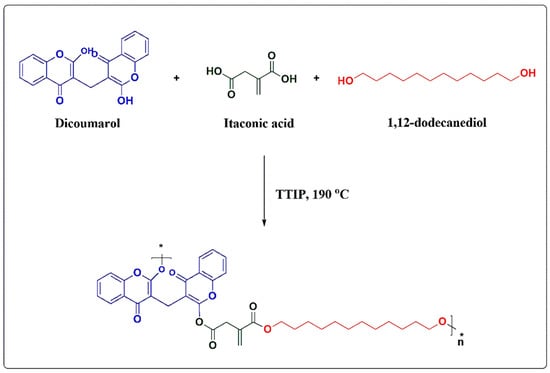
Scheme 1.
Schematic representation of copolyester synthesis process.
2. Materials and Methods
Dicoumarol, itaconic acid, 1,12-dodecanediol, and titanium tetrabutoxide were obtained from Sigma-Aldrich. Unless otherwise specified, all chemicals used were of an analytical grade and used without further purification. Michigan Cancer Foundation-7 (MCF-7) cell lines were sourced from the King Institute, Guindy, Chennai, while VERO cell lines were provided by the National Centre for Cell Sciences (NCCS), Pune. Methanol and ethanol, both of an analytical reagent (AR) grade from Merck-India, were refluxed over quicklime for six hours and then distilled at boiling points of 65 °C and 78 °C. Additional solvents, such as dimethylformamide (DMF), tetrahydrofuran (THF), hexane, acetone, pyridine, and chlorobenzene, were procured from Merck. Spectral-grade dimethylsulfoxide-d6 (DMSO-d6) was used to record the NMR spectrum of the copolyester. Minimal Essential Medium (MEM) was acquired from Hi-Media Laboratories, and fetal bovine serum (FBS) was sourced from Cistron Laboratories. The cell cultures were maintained in MEM supplemented with 10% FBS, penicillin, and streptomycin, and incubated in a CO2-humidified atmosphere at 37 °C.
2.1. Instrumentation and Characterization Methods
The FT-IR spectra of the copolyester were recorded using a Perkin Elmer IR spectrometer (PerkinElmer, Shelton, CT, USA) over the range of 4000–400 cm−1, with KBr pellets employed as the medium. 1H and 13C NMR spectra were obtained using a Bruker 300 MHz instrument (Bruker Corporation, Billerica, MA, USA), with DMSO-d6 as the solvent. The thermal degradation properties of the copolyester were analyzed using Differential Scanning Calorimetry (DSC) on a Q200 V24.10 Build 122 instrument (New Castle, DE, USA). For this analysis, 2–4 mg of the polymer sample was heated from −80 °C to 500 °C under a nitrogen atmosphere at a heating rate of 10 °C/min. The surface morphologies of the pristine and degraded copolyester were examined using a field-emission electron microscope (FEI Quanta FEG 200), equipped with an electron probe micro-analyzer system, utilizing scanning electron microscopy (SEM) imaging techniques.
2.2. Synthesis of the Dicoumarol-Based Copolyester
The synthesis process began by combining itaconic acid (0.02 mol), dicoumarol (0.01 mol), and 1,12-dodecanediol (0.01 mol) in a reaction vessel under nitrogen purging to eliminate the oxygen [19]. The mixture was then gradually heated in an oil bath and the temperature was increased at a rate of 10 °C/min until it reached 190 °C. The reaction temperature was then maintained for 2 h. Simultaneously, water, which was generated as a by-product of the reaction, was removed under vacuum for 1 h. Once water generation ceased, a titanium tetraisopropoxide (TTIP) catalyst (0.1 mmol) was added to the reaction mixture. The reaction was continued under reduced pressure (below 0.5 mmHg) to facilitate condensation polymerization at 190 °C. As the reaction progressed, the mixture became highly viscous, hindering the movement of the magnetic stirrer. After the completion of the reaction, the mixture was gradually cooled to room temperature under a nitrogen atmosphere. The resulting crude copolyester was purified by dissolving it in chloroform and precipitating it in ice-cold methanol with stirring. The solid precipitate was collected by filtration and dried under vacuum at 40 °C for 12 h, yielding the final product in a 75% yield. The number-average molecular weight (Mn) of the synthesized copolyester was determined to be 3.0 × 103, and the weight-average molecular weight (Mw) was 5.9 × 103, as measured by gel permeation chromatography (GPC). These values correspond to a polydispersity index (PDI) of 1.96, indicating a moderate molecular weight distribution.
2.3. Assessment of Anticancer Activity
The anticancer potential of the synthesized copolyester was evaluated using qualitative in vitro cytotoxicity studies [20]. The cytotoxic effects on MCF-7 breast cancer cells were investigated using the 3-(4,5-dimethylthiazol-2-yl)-2,5-diphenyltetrazolium bromide (MTT) assay. MCF-7 cells were cultured in 24-well plates and allowed to reach confluence for 48 h. Following this, the cells were treated with varying copolyester concentrations dissolved in 0.1% DMSO and incubated for 48 h at 37 °C. The samples were buffered with a phosphate buffer solution (pH 7.4) before the addition of MTT in phosphate-buffered saline. After a 4 h incubation with MTT, a solution of 0.04 M HCl in isopropanol was added to dissolve the formazan crystals, and cell viability was assessed by measuring absorbance at 570 nm using a UV spectrophotometer. The concentration required to inhibit 50% cell viability (IC50) was determined graphically from the absorbance data. The effect of the copolyester on MCF-7 cell proliferation was quantified as a percentage of cell viability and calculated using the following formula:
2.4. Exploration of Drug Delivery Potential
The potential of the synthesized copolyesters for drug delivery applications was explored. A 40% copolyester solution in chloroform was prepared and used as a coating solution, which was applied to core tablets containing tamoxifen citrate using a coating pan. The tablets were subjected to continuous hot airflow until the solvent evaporated completely, followed by thorough drying. To evaluate the drug release from the coated tablets, the weight gain attributed to the copolyester coating on tamoxifen citrate was measured. For a quantitative analysis of tamoxifen citrate release, a standard curve was established using the phosphate buffer solution (pH 7.4) as the medium. The absorbance of the standard drug solution was measured at 258 nm (λmax), allowing the construction of a standard curve that correlates absorbance with drug concentration over a specified range. Weight loss (WL) of the drug was calculated using the following equation:
where Wi represents the initial weight of the drug incorporated into the copolyester and Wf is the weight of the drug remaining after the release process.
3. Results and Discussion
The solubility of polymers is a key factor in processing and is influenced by various physical attributes, such as polarity, texture, molecular weight, branching, and crystallinity. In this study, the copolyester demonstrated good solubility in polar solvents like DMSO, DMF, THF, and acetone. This enhanced solubility is primarily attributed to the reduction in crystallinity, as shown in Table 1. The crystallinity of polymers is characterized by tightly packed, highly ordered regions that tend to limit their solubility by restricting the access of solvent molecules to the polymer chains. When crystallinity decreases, the polymer structure becomes more amorphous and disordered, allowing solvent molecules to penetrate more easily and interact with the polymer chains, thereby increasing solubility. The inclusion of dicoumarol, itaconic acid, and 1,12-dodecanediol in the copolyester formulation disrupted the regular packing of polymer chains. This disruption reduces crystallinity and, as a result, enhances polymer solubility.

Table 1.
Solubility of the copolyester in various solvents.
FT-IR spectroscopy of the copolyester revealed a distinct absorption peak at 1730 cm−1, which is indicative of ester C=O stretching, confirming the formation of the copolyester chain within the polymer matrix [21]. This observation is further supported by bands detected at 1180 cm−1, corresponding to C-O stretching vibrations. Additionally, a peak at 1640 cm−1 can be attributed to the C=C stretching vibration characteristic of itaconic acid [22]. A shoulder peak at 2962 cm−1 was assigned to the C–H stretching vibration of the methylene (–CH₂–) group present in itaconic acid, while the broad range between 2800 and 3100 cm−1 (dotted region) corresponded to both aliphatic and aromatic C–H vibrations [23]. Moreover, the peak at approximately 3400 cm−1 is associated with hydroxyl stretching vibrations. The peaks near 1450 cm−1 are linked to the -CH₂– bending vibrations of the methylene groups in the esters. Figure 1 shows the IR spectra of the synthesized copolyester.
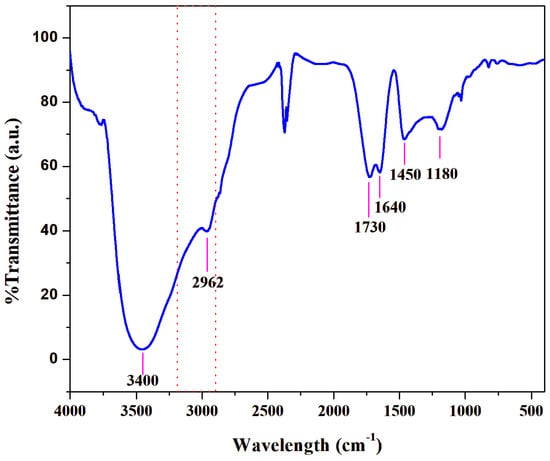
Figure 1.
FTIR spectrum of copolyester.
The 1H- and 13C-NMR spectra of the synthesized copolyester are shown in Figure 2. The 1H-NMR spectrum revealed alkene peaks around 5.8 ppm, which is consistent with previous findings [24]. The detection of an itaconic acid peak in the synthesized copolyester indicates that no cross-linking occurred during the polymerization process. Chemical shifts between 3.8 and 3.9 ppm were assigned to the O-CH₂ protons, while peaks at 2.1 ppm and 1.6 ppm corresponded to the methylene protons of dicoumarol and dodecanediol, respectively. Additionally, peaks observed between 7 and 8.3 ppm were attributed to the aromatic protons of dicoumarol [23]. In the 13C-NMR spectrum, peaks at approximately 33–34 ppm were linked to the terminal methylene carbon, while those near 25 ppm were assigned to the central methylene carbon. Distinctive peaks at 124 and 132 ppm indicate the presence of alkene carbons in itaconate, and the peak at approximately 165 ppm corresponds to the carbonyl carbons in itaconate. Aromatic carbon was identified at 102–210 ppm. These spectral observations provided valuable insights into the molecular structure and composition of the synthesized copolyester. The analysis also confirmed the incorporation of itaconic acid, dicoumarol, and 1,12-dodecanediol, with the molar ratio calculated from the NMR spectra of approximately 1:1:3, aligned with the expected composition based on the initial reactant ratios.
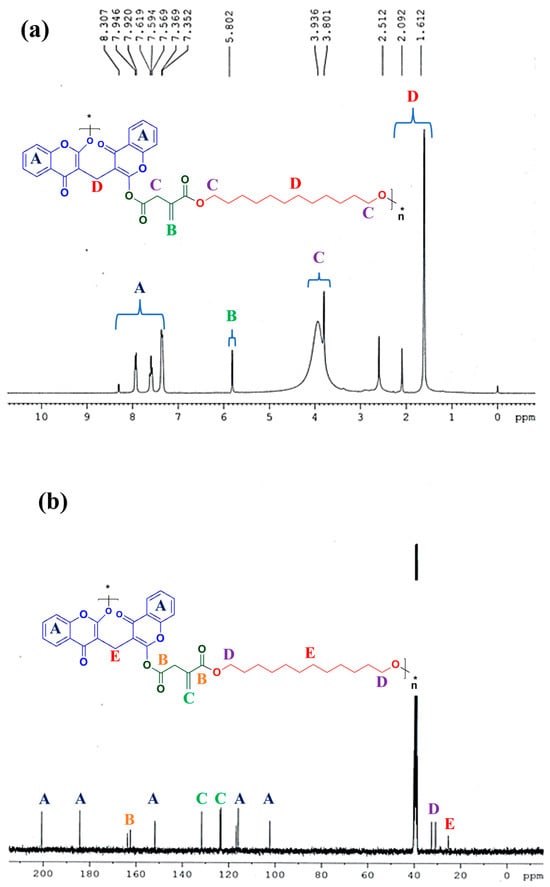
Figure 2.
1H-NMR (a) and 13C-NMR (b) spectra of copolyester.
Differential Scanning Calorimetry (DSC) is an essential technique for determining key thermal properties, such as glass transition temperature (Tg), melting temperature (Tm), and decomposition temperature (Td), as well as assessing the degree of crystallinity (Figure 3). For the synthesized copolyester, a pronounced endothermic peak was observed at 280.35 °C, corresponding to its decomposition temperature. This high decomposition temperature indicates that the copolyester can withstand elevated temperatures. Additionally, the melting temperature (Tm) was recorded as an endothermic peak at 68 °C, which is slightly above the normal human body temperature, suggesting its suitability for applications that require stability at physiological temperatures. The glass transition temperature (Tg) was measured to be −26 °C, which is significantly lower than room temperature, underscoring the material’s flexibility and elastic properties. These thermal characteristics provide valuable insights into the behavior of the synthesized copolyesters and indicate their potential for biomedical applications.
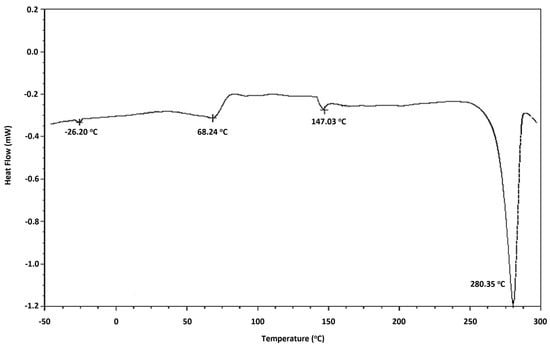
Figure 3.
DSC thermogram of copolyester.
The surface morphology of the copolyester was analyzed using SEM before and after the degradation. Initially, the copolyester exhibited a smooth flower-like surface (Figure 4a). However, after 24 h of exposure to the phosphate buffer solution (pH 7.4), significant changes were observed. The surface became more irregular with an increase in the number of pits and cracks (Figure 4b). These irregularities intensified with prolonged exposure, indicating the susceptibility of the copolyester to degradation under physiological conditions. This degradation behavior suggests that the copolyester could be particularly useful in controlled drug delivery systems, where the rates of degradation and release can be precisely managed. To further quantify this degradation, GPC was performed on the samples after the degradation. The results showed a significant decrease in molecular weight, with the number-average molecular weight (Mn) dropping to 0.5 × 103 and the weight-average molecular weight (Mw) decreasing to 0.6 × 103. These findings confirm that the polymer chains break down during degradation, reinforcing the potential of these copolyesters for applications that require controlled degradation. The observed morphological changes provide valuable insights into the degradation process of the copolyester over time.
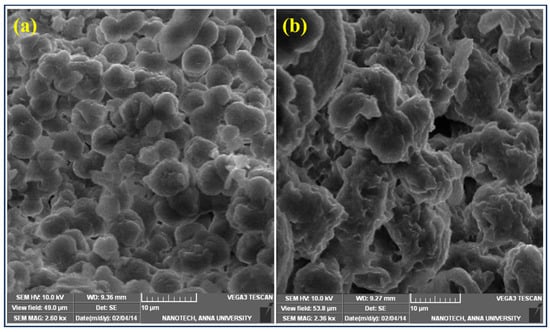
Figure 4.
SEM images of copolyester before (a) and after (b) degradation.
The cytotoxicity of the samples against MCF-7 cells was evaluated using the MTT assay. MCF-7 cells were seeded at a density of 1 × 10⁵ cells per well in 1 mL of the medium in 24-well plates (Costar Corning, Rochester, NY, USA) and allowed to reach confluence after 48 h of incubation. The cells were then treated with various concentrations of the samples dissolved in 0.1% DMSO and incubated for 48 h at 37 °C. After the incubation period, the sample solutions were removed and the cells were rinsed with saline (pH 7.4). Subsequently, 200 µL of the 0.5% MTT solution in phosphate-buffered saline was added to each well. After a 4 h incubation, 0.04 M HCl in isopropanol was added to solubilize the formazan crystals formed by viable cells. Cell viability was then quantified by measuring the absorbance, and the impact of the samples on MCF-7 cell proliferation was expressed as a percentage of viable cells (Table 2).

Table 2.
Anticancer effects of copolyester on MCF-7 cells.
The cytotoxic effects of the copolyester at various concentrations are shown in Figure 5. As the concentration of the copolyester increased, a significant decrease in cell viability was observed. At 1000 µg/mL, nearly 80% of the cells were non-viable, with only 19.2% remaining viable, as shown in Table 2, compared to the control group. In contrast, the lowest concentration of 31.2 µg/mL showed no noticeable impact on cell proliferation. At a concentration of 62.5 μg/mL, the copolyester inhibited cell proliferation by 48%, leaving approximately 52% of the cells as viable. These results indicated that the cytotoxic effects were concentration-dependent, with the synthesized copolyester exhibiting significant cytotoxicity against MCF-7 cells. The IC50 value was determined to be 62.5 μg/mL, highlighting the potency of the copolyester at lower concentrations.
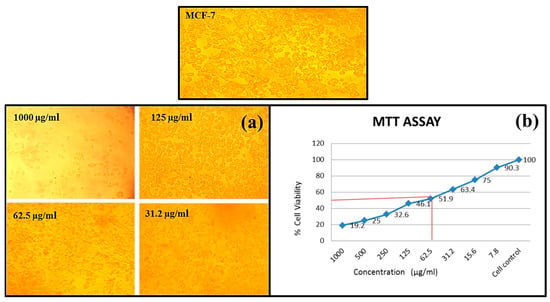
Figure 5.
Cytotoxic effects of copolyester on MCF-7 (control) cell lines, showing (a) varying levels of toxicity (scale bar: 100 µm) and (b) cell viability at different concentrations.
The release profile of tamoxifen citrate (indicated by the star symbol) is shown in Figure 6. The data revealed an initial rapid release during the first 12 h, followed by a more gradual and sustained release from 12 h to 24 h, continuing up to 120 h (5 days). This pattern suggested a strong interaction between the copolyester matrix and tamoxifen citrate. Several factors likely influence the drug-release rate, including the molecular weight, degree of crystallinity, glass transition temperature (Tg), and melting temperature (Tm). The presence of dicoumarol in the polymer backbone, which contains an unsaturated moiety, appears to accelerate the release rate, highlighting the potential of the copolyester as an effective drug delivery system.
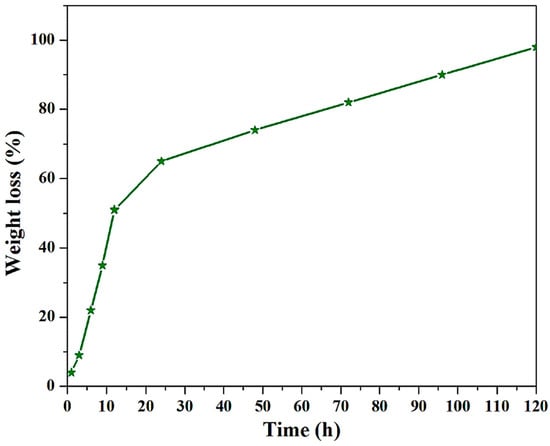
Figure 6.
In vitro tamoxifen citrate release profile of copolyester.
4. Conclusions
The increasing demand for innovative biodegradable and biocompatible copolyesters, particularly in biomedical engineering, has highlighted the need to develop new materials. In response to this demand, we successfully synthesized a novel copolyester by integrating carefully selected monomers with distinct functional groups to impart the desired properties for potential applications in drug delivery systems. In this study, a straightforward synthetic approach was employed to fabricate and characterize a dicoumarol-based copolyester. Comprehensive analyses, including FT-IR, NMR, thermal properties, biodegradability, and biocompatibility analyses, were conducted to thoroughly evaluate the characteristics and potential applications of the synthesized copolyester. The results revealed that the copolyester exhibited significant cytotoxicity against cancer cells, demonstrating its ability to effectively kill cancer cells at a minimum concentration of approximately 60%. These promising findings suggest that this novel copolyester has substantial potential for use in cancer treatment and drug delivery. Overall, the development of this aromatic copolyester represents a notable advancement in the field of biomaterials, offering versatile properties and opening new avenues for future research and applications in various biomedical engineering contexts.
Author Contributions
Conceptualization, G.J., T.K. and S.S.; Methodology, G.J., U.V. and S.S.; Software, G.J., U.V., T.K. and S.S.; Validation, U.V., T.K. and S.S.; Formal analysis, G.J., U.V. and S.S.; Investigation, G.J., U.V. and S.S.; Resources, U.V., T.K. and S.S.; Data curation, G.J., U.V. and S.S.; Writing—original draft preparation, G.J. and U.V.; Writing—review and editing, S.S. and T.K.; Visualization, G.J., U.V. and S.S.; and Supervision, S.S. and T.K. All authors have read and agreed to the published version of the manuscript.
Funding
This research received no external funding.
Data Availability Statement
Data are contained within the article.
Acknowledgments
The authors would like to express their gratitude to the PG and Research Department of Chemistry for providing the laboratory facilities necessary for conducting this research.
Conflicts of Interest
The authors declare no conflicts of interest.
References
- Parvez, A.; Meshram, J.; Tiwari, V.; Sheik, J.; Dongre, R.; Youssoufi, M.H.; Hadda, T.B. Pharmacophores modeling in terms of prediction of theoretical physico-chemical properties and verification by experimental correlations of novel coumarin derivatives produced via Betti’s protocol. Eur. J. Med. Chem. 2010, 45, 4370–4378. [Google Scholar] [CrossRef] [PubMed]
- Brandt, K.; Kruszynski, R.; Bartczak, T.J.; Porwolik-Czomperlik, I. AIDS-related lymphoma screen results and molecular structure determination of a new crown ether bearing aziridinylcyclophosphazene, potentially capable of ion-regulated DNA cleavage action. Inorganica Chim. Acta. 2001, 322, 138–144. [Google Scholar] [CrossRef]
- Asmafiliz, N.; Kılıç, Z.; Öztürk, A.; Hökelek, T.; Koc, L.Y.; Açık, L.; Kısa, O.z.l.; Albay, A.; Üstündağ, Z.; Solak, A.O. Phosphorus− Nitrogen Compounds. 18. Syntheses, stereogenic properties, structural and electrochemical investigations, biological activities, and DNA interactions of new spirocyclic Mono-and bisferrocenylphosphazene derivatives. Inorganic Chem. 2009, 48, 10102–10116. [Google Scholar] [CrossRef]
- Sashidhara, K.V.; Kumar, M.; Modukuri, R.K.; Srivastava, A.; Puri, A. Discovery and synthesis of novel substituted benzocoumarins as orally active lipid modulating agents. Bioorg. Med. Chem. Lett. 2011, 21, 6709–6713. [Google Scholar] [CrossRef]
- Sun, C.; Zhao, W.; Wang, X.; Sun, Y.; Chen, X. A pharmacological review of dicoumarol: An old natural anticoagulant agent. Pharmacol. Res. 2020, 160, 105193–105198. [Google Scholar] [CrossRef] [PubMed]
- Teijón, C.; Guerrero, S.; Olmo, R.; Teijón, J.M.; Blanco, M.D. Swelling properties of copolymeric hydrogels of poly(ethylene glycol) monomethacrylate and monoesters of itaconic acid for use in drug delivery. J. Biomed. Mater. Res. Part B Appl. Biomater. 2009, 91, 716–726. [Google Scholar] [CrossRef]
- Sano, M.; Tanaka, T.; Ohara, H.; Aso, Y. Itaconic acid derivatives: Structure, function, biosynthesis, and perspectives. Appl. Microbiol. Biotechnol. 2020, 104, 9041–9051. [Google Scholar] [CrossRef]
- Deoghare, C.; Balaji, S.; Dhandapani, S.; Srivastava, H.; Ganguly, A.; Chauhan, R. Antimicrobial and anticancer activities of copolymers of tri-O-acetyl-D-glucal and itaconic anhydride. J. Serb. Chem. Soc. 2022, 87, 629–640. [Google Scholar] [CrossRef]
- Joshi, D.C.; Saxena, S.; Jayakannan, M. Development of l-lysine based biodegradable polyurethanes and their dual-responsive amphiphilic nanocarriers for drug delivery to cancer cells. ACS Appl. Polym. Mater. 2019, 1, 1866–1880. [Google Scholar] [CrossRef]
- Arezi, N.; Oh, J.K. Carbonylimidazole-hydroxyl coupling chemistry: Synthesis and block copolymerization of fully bio-reducible poly (carbonate-disulfide)s. Polymer 2020, 206, 122793–122804. [Google Scholar] [CrossRef]
- Prabakaran, R.; Marie, J.M.; Xavier, A.J.M. Biobased Unsaturated Polyesters Containing Castor Oil-Derived Ricinoleic Acid and Itaconic Acid: Synthesis, In Vitro Antibacterial, and Cytocompatibility Studies. ACS Appl. Bio Mater. 2020, 3, 5708–5721. [Google Scholar] [CrossRef] [PubMed]
- Kim, S.K.; Hyun, H.; Kim, S.H.; Yoon, S.J.; Kim, M.S.; Rhee, J.M.; Khang, G.S.; Lee, H.B. Osteogenic differentiation of bone marrow stem cells using thermo-sensitive hydrogels. Polymer 2006, 30, 196–201. [Google Scholar]
- Edlund, U.; Albertsson, A.C. Polyesters based on diacid monomers. Adv. Drug Deliv. Rev. 2003, 55, 585–609. [Google Scholar] [CrossRef]
- Mochizuki, M.; Mukai, K.; Yamada, K.; Ichise, N.; Murase, S.; Iwaya, Y. Structural effects upon enzymatic hydrolysis of poly (butylene succinate-co-ethylene succinate)s. Macromolecules 1997, 30, 7403–7407. [Google Scholar] [CrossRef]
- Baranwal, J.; Barse, B.; Fais, A.; Delogu, G.L.; Kumar, A. Biopolymer: A sustainable material for food and medical applications. Polymer 2022, 14, 983. [Google Scholar] [CrossRef]
- Ye, H.; Wang, K.; Zhao, J.; Lu, Q.; Wang, M.; Sun, B.; Shen, Y.; Liu, H.; Pané, S.; Chen, X.Z.; et al. In situ sprayed nanovaccine suppressing exosomal PD-L1 by golgi apparatus disorganization for postsurgical melanoma immunotherapy. ACS Nano 2023, 17, 10637–10650. [Google Scholar] [CrossRef]
- Kataoka, K.; Harada, A.; Nagasaki, Y. Block copolymer micelles for drug delivery: Design, characterization and biological significance. Adv. Drug Deliv. Rev. 2012, 64, 37–48. [Google Scholar] [CrossRef]
- Pişkin, M.; Durmuş, M.; Bulut, M. Highly soluble 7-oxy-3-(4-methoxyphenyl) coumarin bearing zinc phthalocyanines: Synthesis and investigation of photophysical and photochemical properties. J. Photochem. Photobiol. A 2011, 223, 37–49. [Google Scholar] [CrossRef]
- Veerabagu, U.; Jaikumar, G.; Fushen, L. A facile synthesis of itaconic acid based biodegradable co-polyesters: An in-vitro anticancer evaluation and controlled drug delivery system. J. Polym. Environ. 2019, 27, 2756–2768. [Google Scholar] [CrossRef]
- Udayakumar, V.; Gowsika, J.; Pandurangan, A. A novel synthesis and preliminary in vitro cytotoxic evaluation of dihydropyrimidine-2, 4 (1 H, 3 H)-dione derivatives. J. Chem. Sci. 2017, 129, 249–258. [Google Scholar] [CrossRef]
- Christodoulou, E.; Notopoulou, M.; Nakiou, E.; Kostoglou, M.; Barmpalexis, P.; Bikiaris, D.N. Branched poly (ε-caprolactone)-based copolyesters of different architectures and their use in the preparation of anticancer drug-loaded nanoparticles. Int. J. Mol. Sci. 2022, 23, 15393. [Google Scholar] [CrossRef] [PubMed]
- Naderi, P.; Kabiri, K.; Jahanmardi, R.; Zohuriaan-Mehr, M.J. Preparation of itaconic acid bio-based cross-linkers for hydrogels. J. Macromol. Sci. Part A 2021, 58, 165–174. [Google Scholar] [CrossRef]
- Asad, M.; Arshad, M.N.; TN, M.M.; Asiri, A.M. Chitosan Catalyzed Novel Piperidinium Dicoumarol: Green Synthesis, X-ray Diffraction, Hirshfeld Surface and DFT Studies. Polymer 2022, 14, 1854. [Google Scholar] [CrossRef]
- Dixit, A.; Sabnis, A.; Balgude, D.; Kale, S.; Gada, A.; Kudu, B.; Mehta, K.; Kasar, S.; Handa, D.; Mehta, R.; et al. Synthesis and characterization of citric acid and itaconic acid-based two-pack polyurethane antimicrobial coatings. Polym. Bull. 2023, 80, 2187–2216. [Google Scholar] [CrossRef]
Disclaimer/Publisher’s Note: The statements, opinions and data contained in all publications are solely those of the individual author(s) and contributor(s) and not of MDPI and/or the editor(s). MDPI and/or the editor(s) disclaim responsibility for any injury to people or property resulting from any ideas, methods, instructions or products referred to in the content. |
© 2024 by the authors. Licensee MDPI, Basel, Switzerland. This article is an open access article distributed under the terms and conditions of the Creative Commons Attribution (CC BY) license (https://creativecommons.org/licenses/by/4.0/).